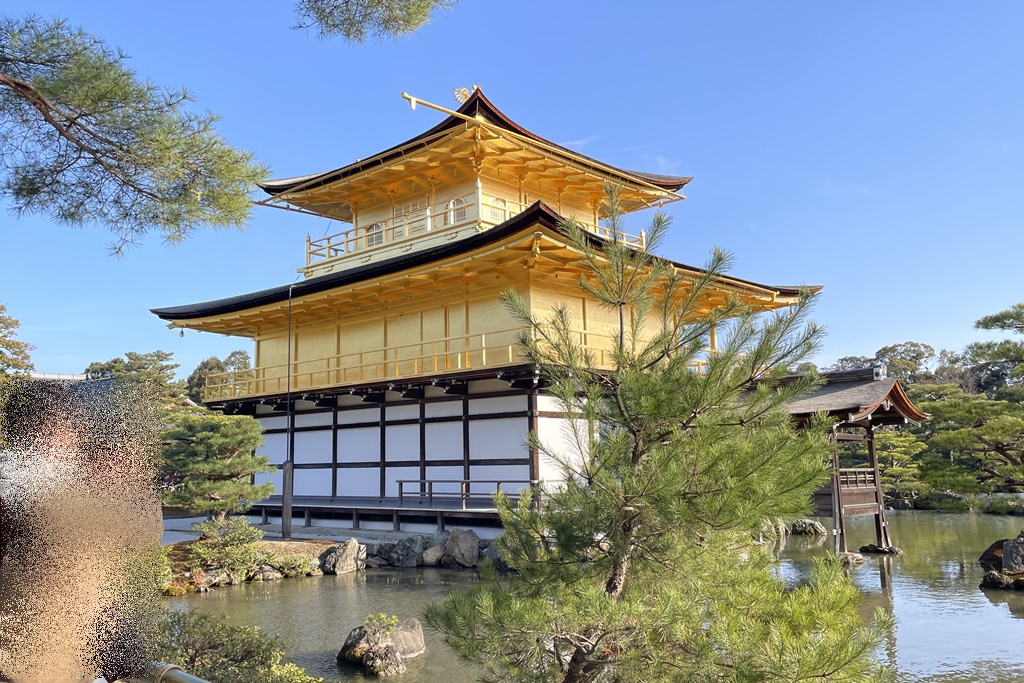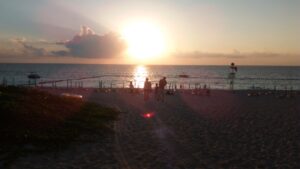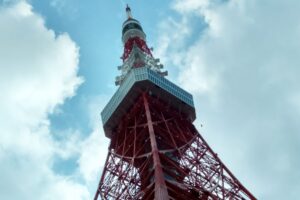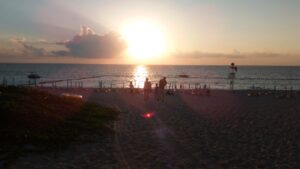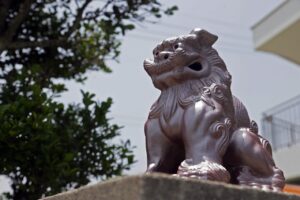As planned, we were heading towards Tokyo but made a stop in Kyoto for 1-day trip. Before leaving England, I had decided what to see. I selected places that I personally wanted to visit, as well as those that seemed interesting for my child, who was visiting Kyoto for the first time. As a result, most of the spots we visited were popular tourist attractions, but I thought that was just part of the fun. Additionally, I had planned the order of these spots in advance to make the trip as efficient as possible.
Considering the time required for bus travel, we planned to visit the following four spots:
- Sanjusangendo (三十三間堂)
- Kiyomizu-dera (清水寺)
- Nijo Castle (二条城)
- Kinkaku-ji (金閣寺)
Train trip from USJ to Kyoto
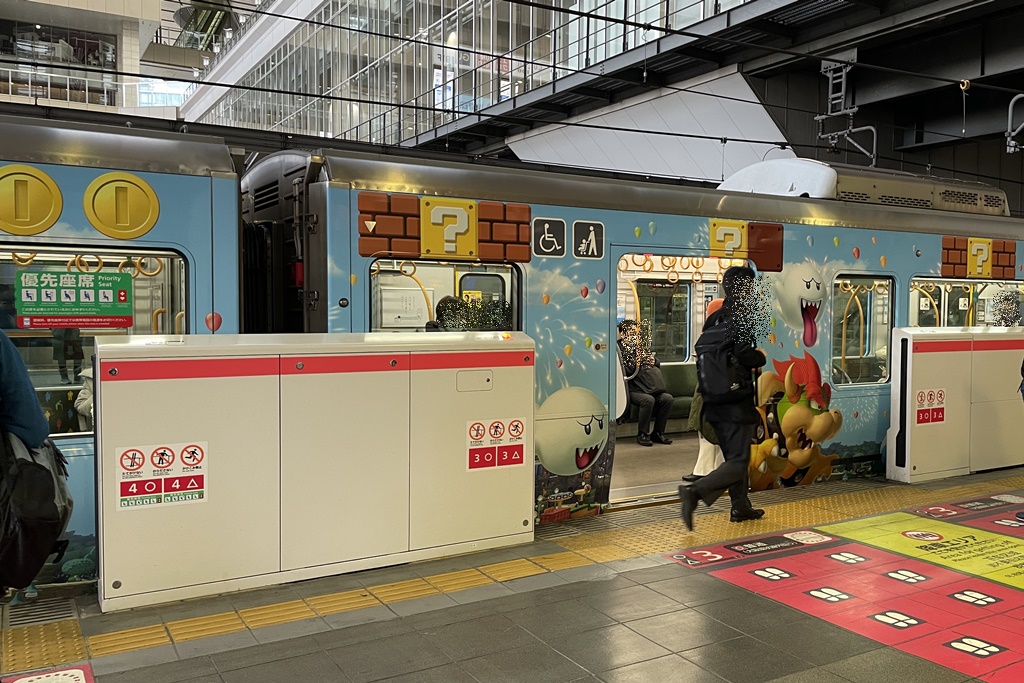
After having breakfast at the hotel near USJ, we took our suitcases and headed to Kyoto. I had researched the train schedules in advance and selected a route with two transfers.
The route was as follows:
- From Sakurajima Station (桜島駅) to Nishikujo (西九条) (Sakurajima Line (桜島線) )
- From Nishikujo to Osaka (大阪) (JR Kansai Main Line (JR関西本線) )
- From Osaka to Kyoto (京都) (JR Tokaido Line (JR東海本線) )
I had also looked into locker locations at Kyoto Station beforehand, but upon arrival, I found that there were several locker signs, so we decided to use the nearest one. Here, I highly recommend taking photos of the locker itself, its location, and landmarks leading to it whenever possible. We had only relied on the escalator’s features and nearby signs, which led to a difficult situation when we had to find the locker again (this will be explained later).
Getting Kyoto 1 day Bus and Subway Pass

Upon leaving Kyoto Station, we saw Kyoto Tower beautifully standing against the blue sky. There was the bus terminal front of the station, and we purchased Kyoto subway & bus 1-day passes at a nearby sales booth. This pass is convenient as it offers unlimited rides on both buses and the subway within Kyoto city. A map provided with the ticket clearly showed the coverage area, highlighting its easy access to major tourist sites in Kyoto. The price for an adult was 1,100 yen.
Sanjusangendo (三十三間堂)
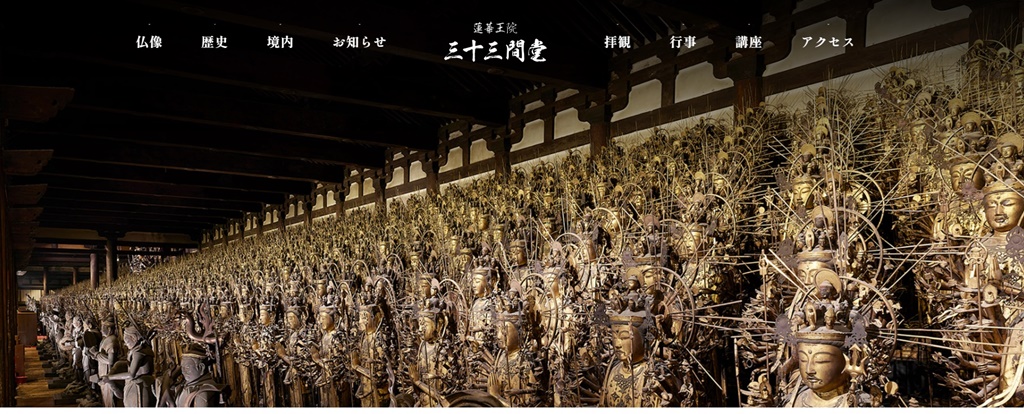
We headed first to Sanjusangendo, a place I had visited for the first time during a school trip in middle school and was deeply impressed by. I had returned as an adult and was again glad to revisit. I thought my child might not enjoy it much, but to my surprise, they showed more interest than I expected, reading various explanations and exploring.
Unfortunately, photography was not allowed inside, but the sight of the 1,001 statues of the Thousand-Armed Kannon, lined up in rows, was overwhelming every time.
Kiyomizu-dera (清水寺)

Next, we headed to Kiyomizu-dera. I had originally planned to walk from Sanjusangendo to there. We quickly found the signs directing us to Kiyomizu-dera, and enjoyed strolling through the charming streets of Kyoto on the way.
As we walked, the number of tourists increased, and I noticed the streets were lined with traditional souvenir shops. There were many school trip students and tourists in kimonos, with kimono rental shops being particularly abundant. I also saw several men walking in kimonos, which was quite striking.
The Symbol of Kiyomizu-dera: The Nioh Gate
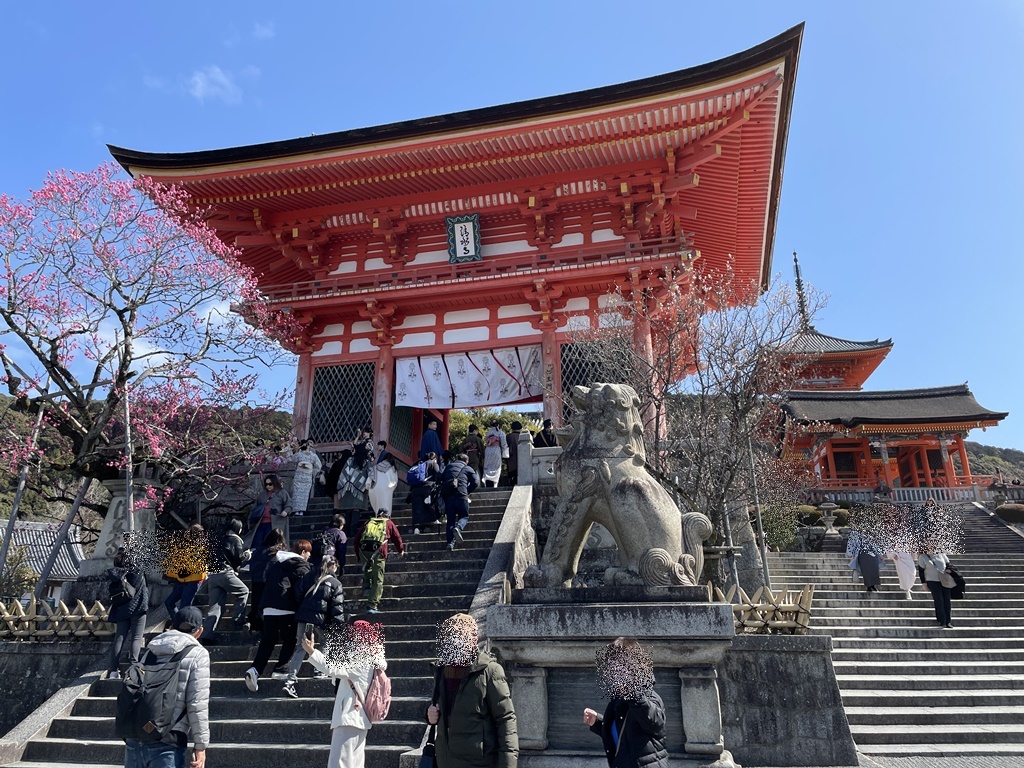
At the entrance to Kiyomizu-dera stands the Nioh Gate (仁王門), a vermilion gate designated as an Important Cultural Asset. Due to its vibrant colour, it is also called the “Red Gate (赤門).” Its appearance against the blue sky is stunning, and from the moment we arrived, it gave us a sense of the special atmosphere of Kiyomizu-dera.
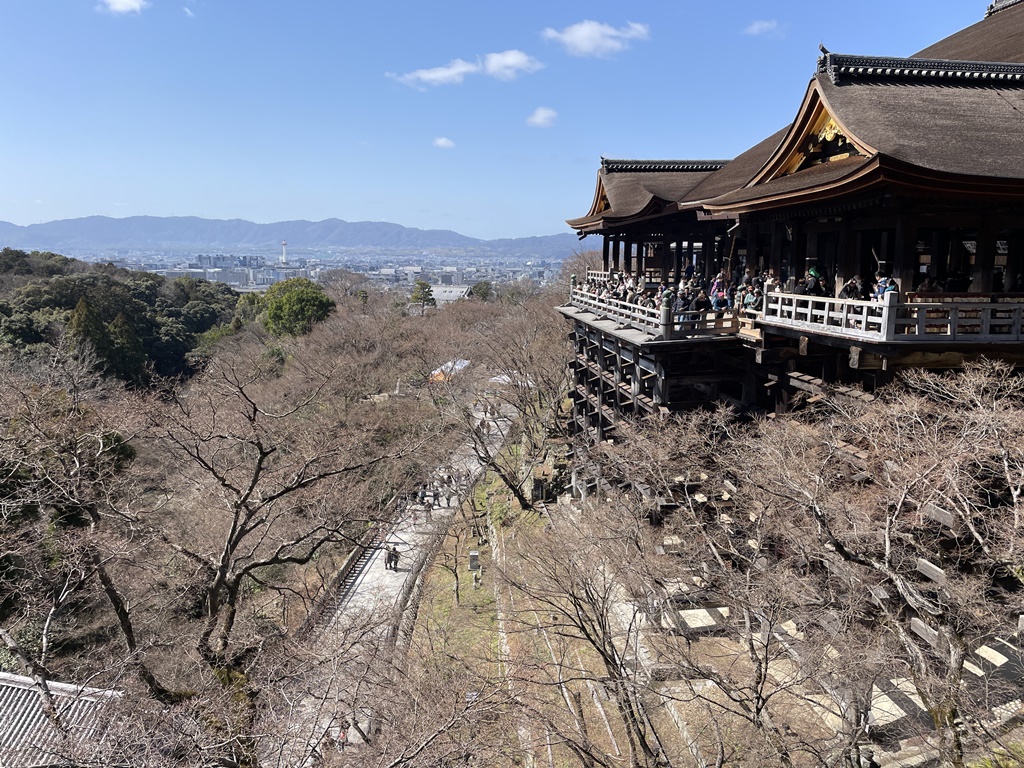
This temple was established in 778 (the 9th year of Hōki (宝亀)) by the monk Enchin (延鎮上人). It enshrines the Kannon Bodhisattva (観音菩薩) and is modelled after a mountain in southern India where Kannon is said to descend, which is why it is located on a cliff. The stage of Kiyomizu-dera, where worshippers continuously walk, was later constructed with scaffolding to accommodate the increasing number of visitors. When viewed from a distance, its height and structure are clear. Additionally, Kiyomizu-dera was registered as a UNESCO World Heritage Site in 1994.
Regarding the stage, there is a Japanese expression “to jump from the stage at Kiyomizu-dera,” which means to make a bold and decisive action. Given that the stage is about 13 meters high, jumping from it is no small feat. In English, this expression is similar to “take the plunge.”
Lunch at Miyako Ramen

After leaving Kiyomizu-dera, we were searching for a place to have lunch when we stumbled upon the ramen shop “Kyoto Gion Ramen Miyako” and decided to give it a try. We ordered the Miyako ramen and the chicken salt ramen, and before digging in, we sampled each other’s broth. Both were absolutely delicious.
My child prefers Japanese food over British cuisine (partly because I often cook Japanese dishes at home), and since arriving in Japan, they have been thoroughly enjoying every meal.
Nijo Castle (二条城)

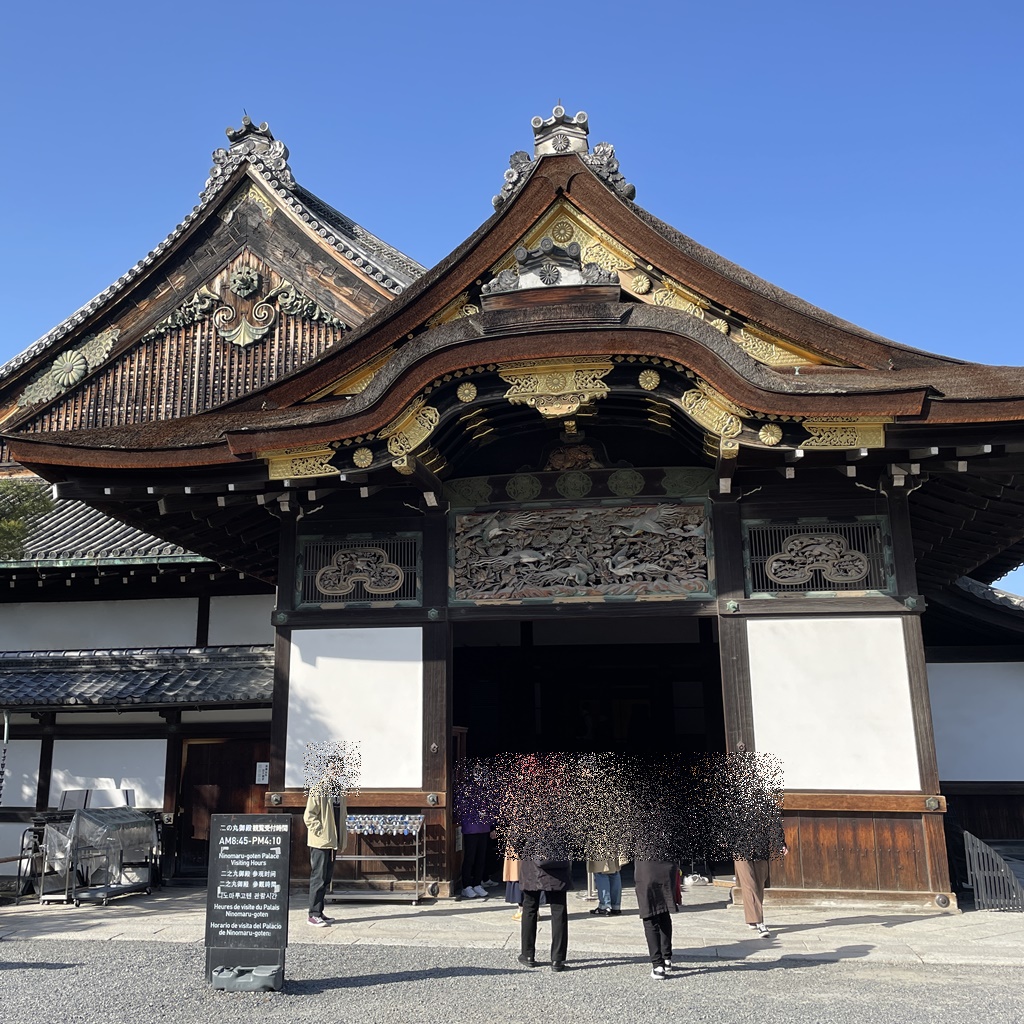
After lunch, we took the bus to Nijo Castle. We had watched a Japanese TV show together with my child at our home in England, which often featured Kyoto. Nijo Castle had been introduced several times, so my child was somewhat familiar with it, and we decided to visit.
Photography was not allowed inside the castle. My child walked through the building with great interest, enjoying the Uguisubari (鴬張り) floor, which makes a “creaking” sound when walked upon. The Uguisubari floor is a special construction that produces sound due to metal fixtures installed under the floorboards. This was used for security and surveillance purposes, alerting people to the presence of intruders. While serving as a defensive mechanism, the floor also produces a beautiful sound, symbolizing the exquisite craftsmanship of Japanese architecture.
Kinkaku-ji (金閣寺)
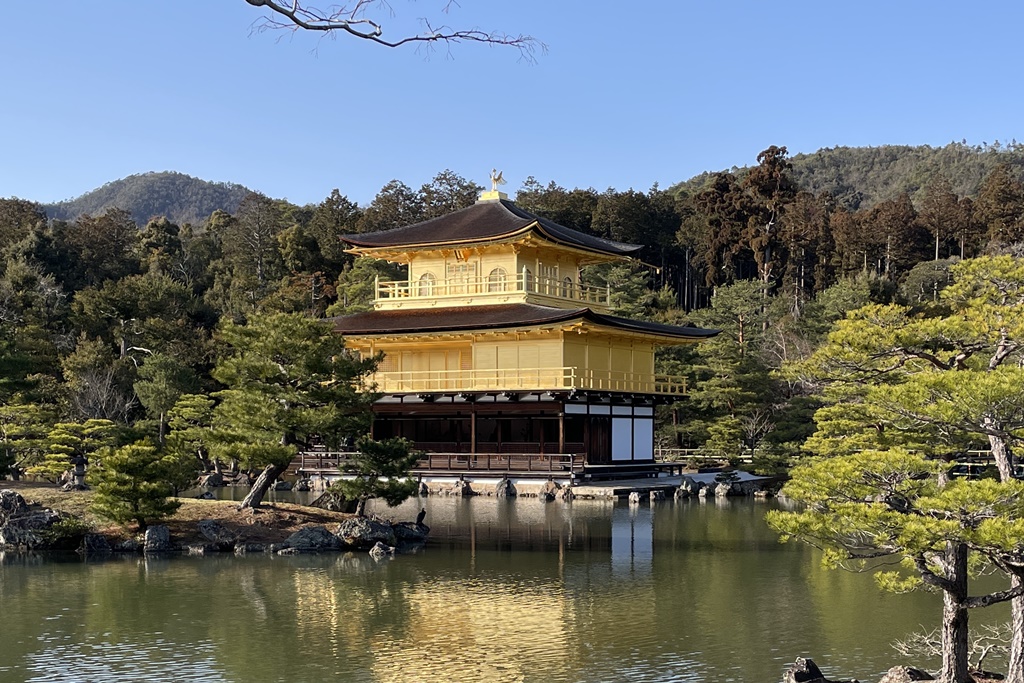
We took another bus to Kinkaku-ji. After paying the entrance fee, we received ofudas (お札),
commemorative charm or talisman as a token of entry at Kinkakuji Temple.
It is inscribed with “Kinkaku Shari-den Goshugo (金閣舎利殿御守護, Gold Pavilion Shari Hall Protection).” This charm is said to bring benefits such as home safety, traffic safety, and academic success, setting Kinkaku-ji apart from other temples.
The reason for this is that when Kyoto City introduced the “Historic Preservation Cooperation Tax,” Kinkaku-ji stopped collecting admission fees and began selling these charms instead. I remember receiving the same charm more than 20 years ago, and this practice has been in place for about 30 years.
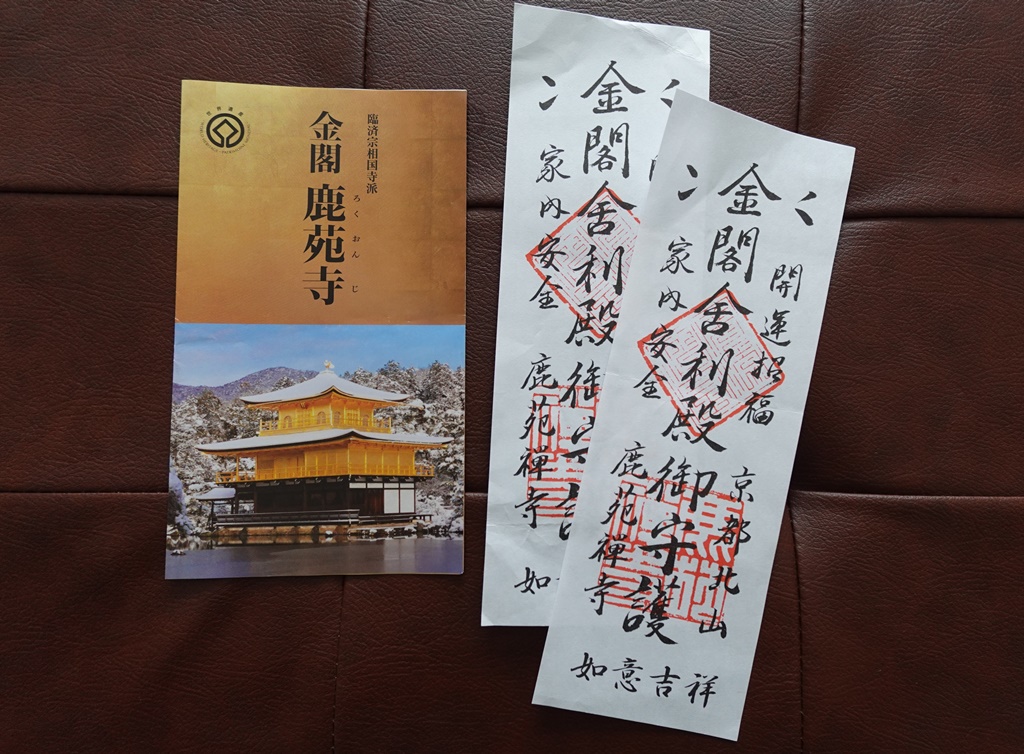
Walking through the temple grounds, we were finally greeted by the beautiful Kinkaku-ji. Built by Ashikaga Yoshimitsu (足利義満), the 3rd shogun (将軍) of the Muromachi Shogunate (室町幕府), in 1397, it was originally his villa. After his death, it was transformed into a Zen temple (禅寺) and named Rokuon-ji (鹿苑寺), after his posthumous Buddhist name. The name “Kinkaku-ji” derives from the golden pavilion, which is covered in gold leaf. The pavilion is a “shari-den (舎利殿),” a building used to house the relics of the Buddha.
Though the interior is not open to the public, the exterior and gardens are worth seeing. Many tourists were taking photos, and I joined them.
Locker Trouble at Kyoto Station
As the time for our return approached, we planned to take the bus back to Kyoto Station, but a staff member at the bus stop advised us that the roads would be getting busy. Therefore, we decided to take the bus to the Kita-Oji (北大路) Bus Terminal, then transfer to the subway to Kyoto Station. We were able to make the most of our one-day pass, which was fortunate.
As the time for our Shinkansen departure drew closer, we found ourselves struggling to locate our suitcase. The main reason was that our locker turned out to be farther away than we had expected. Despite descending the escalator we had used and remembered, not only was our locker missing, but so were all the lockers in the immediate surrounding number range, as if that section had simply vanished. This was especially baffling because all the other locker numbers were arranged in perfect order.
We searched the area frantically, and eventually, we found a cluster of lockers in a place we thought couldn’t possibly be the right location—yet there it was. Yes, this was indeed the locker we had used that morning, but for some inexplicable reason, our locker and the ones around it were isolated and placed far away from the main group of lockers. Why on earth did Kyoto Station decide on such a confusing layout? I couldn’t help but wonder if the people in charge of this arrangement were out of their minds!
Although we somehow managed to catch the Shinkansen, we had no time left to buy souvenirs, and I couldn’t get the Yatsuhashi I had been personally looking forward to. I felt so disappointed that I even considered buying Yatsuhashi at a souvenir shop in Tokyo Station that some might call a “cheating” option for those who forget to buy gifts.
Finally, when we got on the Shinkansen, both my child and I were exhausted. After arriving in Tokyo, we transferred to a local train and eventually reached my parents’ house, but due to poor timing, we hadn’t eaten anything. Fortunately, my parents had bought a variety of foods for us, so we were able to eat and end the long day.
